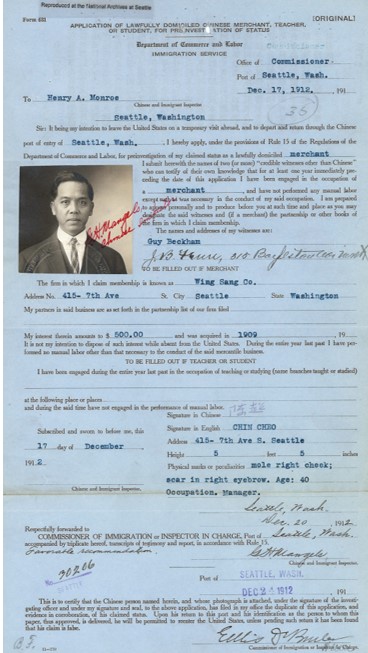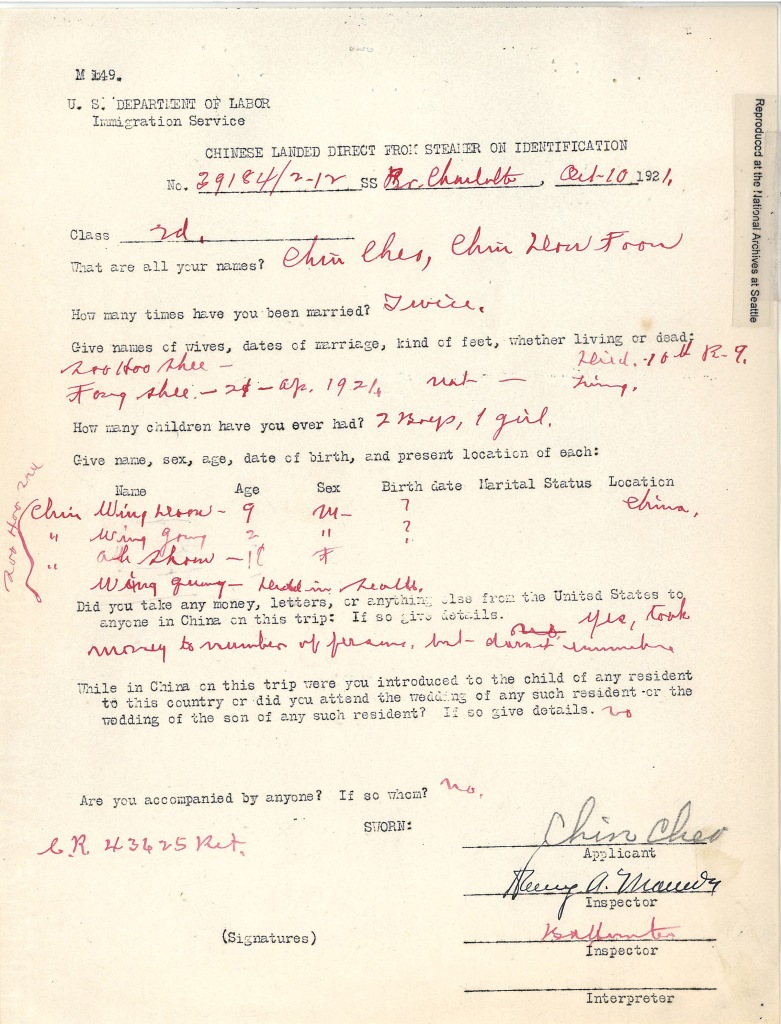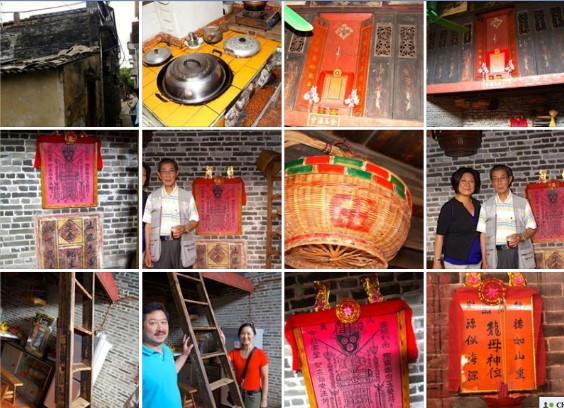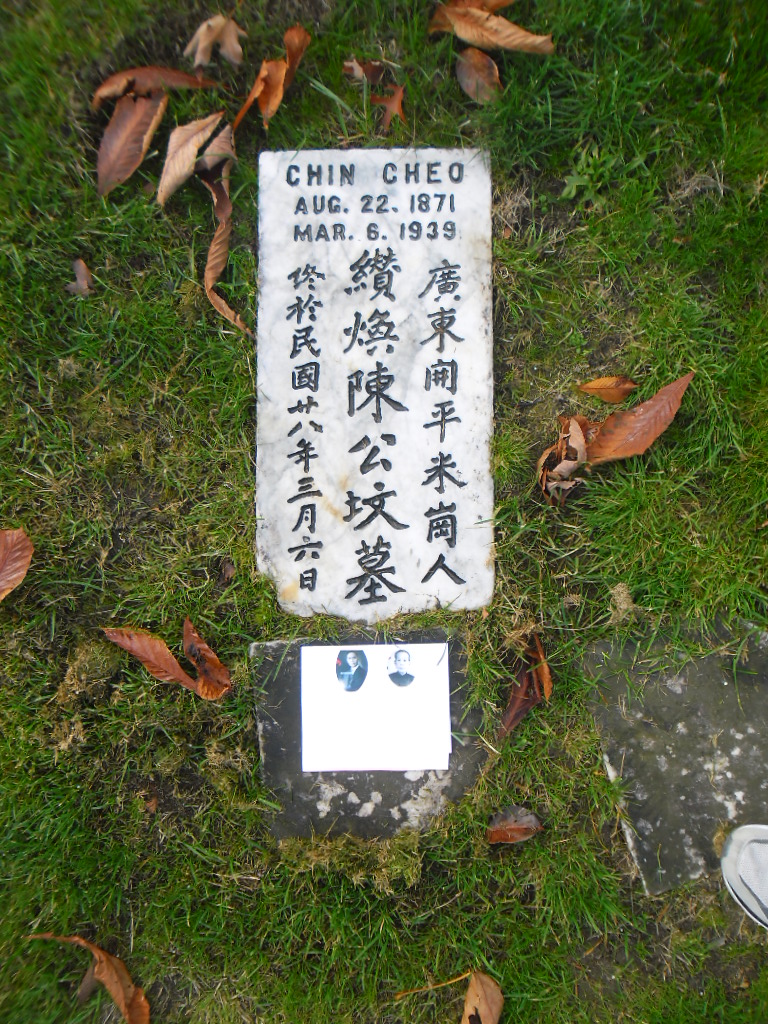The 2016 blog entry for Gim Bing has been updated to include more information from his file.
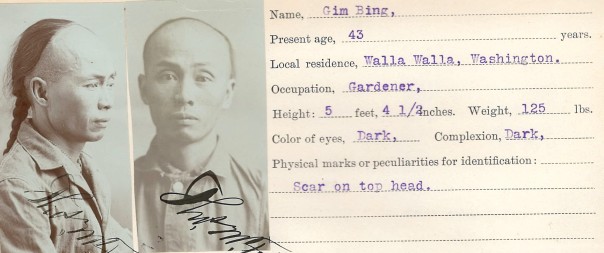
The 2016 blog entry for Gim Bing has been updated to include more information from his file.

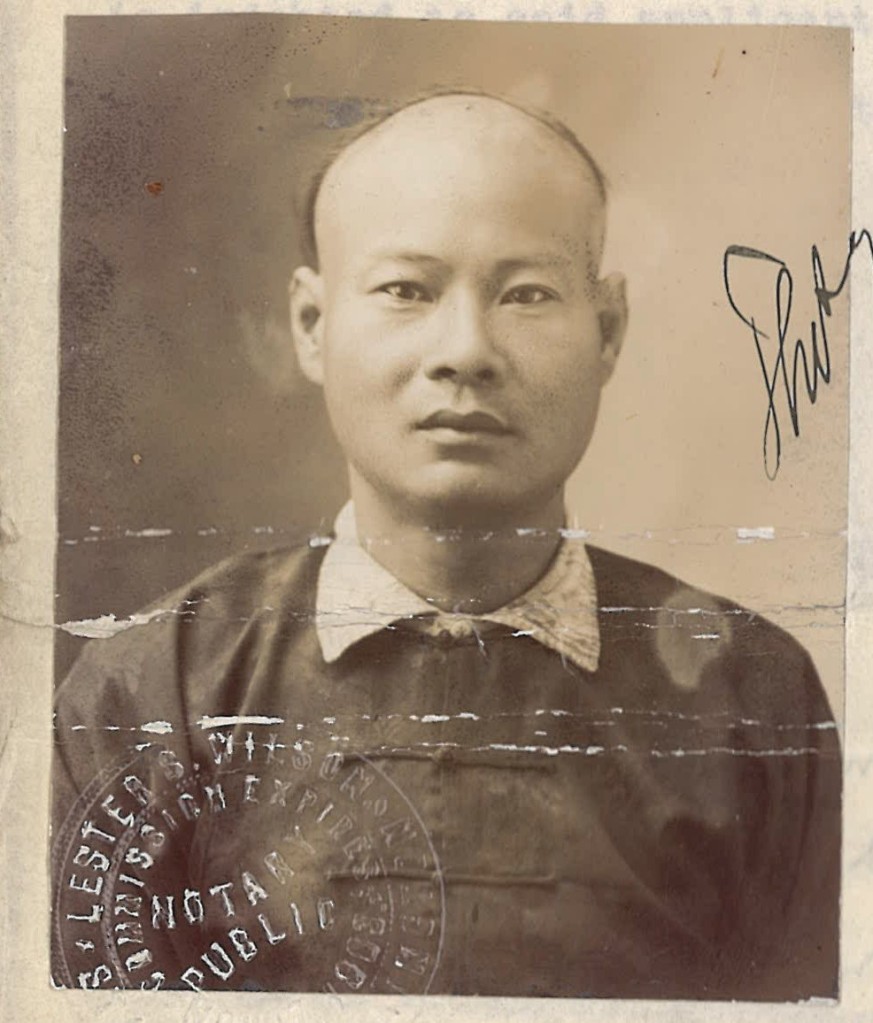
1903 Sept 28 – Lee Poo started the process of obtaining a return certificate which would allow him to reenter the U.S. within a year of his department date. He swore in an affidavit that he was laborer, age 37 years, had been in the United States 23 years and was living in Walla Walla, Washington, and working as a gardener nearby. He was owed more than $1,000 by Jim Lee and Hoy Yam, both of Walla Walla. He handed over his Certificate of Residence which would be returned to him when he reentered the U.S. His photo was attached to the affidavit.
1903 Sept 28 – Jim Lee and Hoy Yam, both from Walla Walla, swore that they owed Lee Poo, a total of $1,100. The Chinese Inspector verified the loans with them.
1903 October 8 – the Commissioner-General at the Bureau of Immigration in Washington, D.C. wrote to the Inspector in Charge in Port Townsend, Washington saying they compared Lee Poo’s duplicate Certificate of Residence that they had in their file and it completely agreed with Lee’s copy. Hoy Yam testified that he still owed Lee Poo money. Jim Lee who worked as a gardener in Walla Walla, also testified that he still owed Lee Poo money.
1904 June 28 – R. B. Scott, the Chinese Inspector at Port Townsend report that Jim Lee and Hoy Yan both said that neither of the debts were in the form of promissory notes.
1904 Aug 24 – When Lee Poo returned to Port Townsend on 25 August 1904, he testified that he was 38 years old and lived in Walla Walla. He had worked in a laundry for three years, then as a cook for fifteen or so years, and as a gardener for the last two years. He saved his earnings and accumulated about $3,500. He took half of it to China and left the remainder with his cousin, Jim Lee who owned a garden in Walla Walla near the O.R. & N (Oregon Railroad and Navigation Company) depot. Lee Poo worked every day of the week for one dollar a day. Jim Lee had only paid him about $40 so he still owed him $500.
Lee Poo loaned $600 in gold coins to Hoy Yan so he could buy an interest in a garden. He kept his money at Quong Chung Seng’s place in Walla Walla. Bow Loy, a member of the firm, was a witness to the transaction and held the notes. He signed an IOU for the money.
Lee Poo also leased a garden with his cousin Lee Hing in Dayton, Washington. They owned a horse and wagon.
Lee Poo’s trip to China involved taking a steamer from Port Townsend to Victoria, another steamer to Vancouver, then the Empress Line to China. After Lee Poo’s return, Jim Lee and Hoy Yan both testified they still owed Lee Poo money.
1904 Aug 27 – Lee Poo was denied admittance and given two days to file an appeal. He filed an appeal.
1904 Sept 6 – Lee Poo told his lawyer that he thought his application for a certificate of departure and return was proof of note for his loans. He gave Bow Loy a slip of Chinese writing paper listing how much money he was owed by Jim Lee and Hoy Yun. It seems that Lee Poo did not understand he was being asked about a legal “promissory note” not just a note reminding him that he was owed money.
He was rejected “on the ground that the debts on which he sought to re-enter the United States were evidenced by promissory notes.”
1904 Sept 14 – The report of R. B. Scott, Chinese Inspector at Port Townsend, to the Inspector in Charge clarified that the monies due Lee Poo were for money borrowed and labor performed; they were not promissory notes. His Book of Debts Owed was offered as evidence of the debts owed by Hoy Yun and Jim Lee.
“Book of Debts Due to Lee Poo,” CEA case files, RG 85, NARA-Seattle, Lee Poo, Box RS 019, file RS 664.
Kwong Si 29 August 10,
Jim Lee, total balance due $500
Lee Poo Count.
Kwong Si 29 August, form other book –
Total –
28 year April 10
Borrowed U.S. gold coin $600
Both agree until next year when I come back.
Huey Yan see Lee Poo count.
(Translated by Chin Kee, Chinese Interpreter)
This case file pertains to the Bayard-Zhang Treaty of 1888 and the 1888 Scott Act. To find out more about them, go to https://www.wikiwand.com/en/Scott_Act_(1888)#Scott_Act
Connecting Families to the Files:
10 July 2023, Debbie Jiang:
Debbie Jiang was so excited to see a summary of her ancestor, Ng Sen Wing, Chinese Exclusion Act case file. She wrote:
“I know these people! Ng Sen Wing and family are related to some of my grandmother’s cousins’ descendants whom I will be seeing in two weeks at our triannual family reunion. They will love knowing all of this! I am busy finding new material on the Canadian side of Chinese exclusion archives and our newly released 1931 census records!”
“Note: Ng Sen Wing’s son, Ng Jung Fie was twice a widower, poor man, but he was instrumental in sponsoring his second wife’s extended family to the U.S. in 1962. Ng Jung Go’s son, Wah Poy, lived to age 85. He married my grandma’s first cousin, Alice, whom he met in Shanghai during the Second World War, introduced by my grandma’s brother (who worked as an immigration officer at Ellis Island, his name is C. H. Yung). What a small world!”
“Wah Poy’s grandson, Gabe Eng-Goetz is an artist in Durham, NC, and in this video he talks about his roots along with showing his box mural painting, a tribute to his Chinese roots!
(Some of the family spelled Ng, “Eng”) Enjoy!


Wong Tew Quay was admitted at the Port of Seattle, Washington, on 1 March 1938, as the wife of a merchant. She was issued Certificate of Identity 76724. She was accompanied by her ten-year-old son, Mah Kang.
Wong Tew Quay and her son Mah Kang also had San Pedro, California files, 14036/82-B and 83-B. A Board of Special Inquiry (BSI) consisting of the chairman, two inspectors, an official government typist and an interpreter interviewed the family. There were fourteen pages of testimony. Most of the interview was with her husband, but her file contained more than five pages of interrogation with her, the subject of the file.
Wong Tew Quay’s husband’s interrogation included this information: Gee Chow Wai (marriage name Seung Din) also had an American name, Harry Wah. His Seattle file listed him as Mah Wai. Because he used several names, he will be referred to as Mah Wai in this summary. He testified that he was born in Hong Soon village, Jee Hung section, Hoy San District, China about 1898. He left China when he was 14 and was admitted to Canada under the name Mah Wai as the son of a merchant, Mah Sang. After his arrival he did not live with Mah Sang but lived in Edmonton with the Gee family. He was asked if he freely admitted that he gained admission to Canada on a fraudulent claim. He answered that he did.
In 1924, Mah Wai’s Section 6 Certificate which allowed merchants to enter the country, was endorsed by the American vice-consul at Calgary, Aberta, Canada. Mah Wai was a partner of the Barrack Grocery store in Edmonton for two years before coming to the U.S. to become a partner of the Gim Ngoon Grocery and Restaurant in Needles, California. From there he made four trips out of the U.S., one to Canada, and three to China. On one of his trips, he married Wong Tew Quay. During his interview, he gave details of his village, wedding, their children, and his extended family. The interviewer asked if he had claimed two false sons in a previous interview and if he intended to bring them into the country for compensation. Mah Wai admitted that he had thought about bringing them in but did not do it, and if he had, he would not have taken money to bring them in.
[The interviews continued in spite of this alarming admission. It is surprising that he wasn’t immediately rejected or deported.]
Wong Tew Quay’s testimony agreed with her husband’s. She testified that her mother arranged their wedding. It was half old custom and half new. She first met Mah Wai on their wedding day. He gave her two gold rings and a pair of gold bracelets. Their wedding feast was held at a small pavilion in the village with music provided by two flutists. Her contributions to her new household were a large square table, several wooden stools and chairs, two ratan chairs, a wardrobe, dressing table and a washstand. Her testimony agreed with her husband’s including knowing about her husband’s claim of two false sons (paper sons).
Their son, Jee Doo Keung (Mah Kang) was also interrogated. His testimony agreed with his parents. He attended school in Hong Soon village. On one of his father’s visits to China, his father gave him a fountain pen and took him to a moving picture show at the Hai Ping theatre in Hoy San city. Jee Doo Keung correctly identified all the family members he was shown in various photographs.
Wong Tew Quay and Mah Wai re-examined and asked to identify the six people in the photo they had given to the American Consul in Canton during their precis interview. Their testimony agreed. Years earlier in a previous testimony Mah Wei told Immigration Service that he lived in Nam Long village but in this current interview he said he was from Hong Soon village. He confessed that as the paper son of Mah Sang, he had to say he was from Nam Long. He admitted that he made up the identifying information about the two paper sons.
The Chairman of Board of Special Inquiry noted that Gee Chow Wai (Mah Wai) was originally admitted to the U.S. from Canada in 1924. Mah Wai showed proof of being a merchant in his four previous trips out of the U.S. The rest of his testimony seemed to be honest and correct; he identified everyone in the photographs correctly; and his son resembled him. A few days earlier Mah Wai told the commissioner that he had gotten involved with a Christian church in Seattle and a woman missionary encouraged him to tell the truth about his fraudulent admission into Canada. Based on this information, Mah Wai, his wife, and son were admitted to the U.S. two weeks after their arrival.
Mah Wai, was naturalized as a United States citizen at San Bernardino, California in December 1947. In 1948 he applied for a nonquota visa for his wife through the office of the American Consul at Vancouver, B. C., Canada. The Seattle immigration office suggested that they contact the Los Angeles, California immigration office since the couple lived in Barstow, California.
There is a 1950 memo in the file that reports to the Seattle Immigration Director that Wong Tew Quay (Mary Wong Gee or Mary Tew Quay Gee) died at Loma Linda, California on 3 November 1949. She was living at Barstow, California at the time of her death.
Mah Wai’s file may have more details about how he managed to be admitted to the U.S. in spite of his admissions of fraud.
Added three books published in 2023 to the Resource Page
Mott Street: A Chinese American Family’s Story of Exclusion and Homecoming by Ava Chin
Everything I Learned, I Learned in a Chinese Restaurant: a memoir by Curtis Chin
The Middle Kingdom under the Big Sky by Mark T. Johnson
The Chinese Exclusion Act case files for Port Townsend, Washington are now available online at the National Archives catalog at https://catalog.archives.gov/search-within/1174261
There are 114 case files of arrivals at Port Townsend between 1906 and 1928. If you need more information to find the person you can search the CEA blog index

In 1949, Immigration Services was contacting Jew Men and his family to update their files. They wanted to see if Jew and his family had applied for permanent resident status, or if they had left the country. This is what Immigration found1:
Jew Men and his mother, Quon Shee, arrived at the Port of Seattle in April 1937. They were classified as a minor son and the wife of a domiciled Chinese Merchant, Jew Woo, a member of the firm of Joe Yuen & Co., of Itta Bena, Mississippi. They were admitted and their certificates of identity, which were held by Immigration Services in their absence, were returned to them.
Jew Men, also known as Clement Joe, was 16 years old, when he was interviewed in 1936. He had gone to school for five years in Mississippi and could speak English, Cantonese, and See Yip Hoy Ping dialects. He was born in November 1920 in Sai Hing village, Lee Toom section of the Hoy Ping district in China. He was seven years old when he first came to the U.S. with his mother. They arrived at the Port of San Francisco in August 1926 and were admitted. He had two younger brothers who stayed in China with his mother’s sister.
Jew Men went back to China with his parents in April 1934. He and his mother did not get Return Certificates before leaving because they thought that were told by the Immigration office that they did not need them. When they wanted to return to the U.S. they applied to the American Consul at Hong Kong for a visa. The status of merchant for Jew Woo, the father and husband of the applicants, was investigated by the New Orleans Office of Immigration and recognized. Jew Men and his mother received a joint non-immigrant visa.
An October 1936 affidavit with the signatures of sixteen citizens of Itta Bena, Leflore County, Mississippi, swearing that they knew Jew Woo (aka Ray W. Joe), a merchant, for several years and that the photos attached were of his wife and son who resided in Itta Bena from October 1926 to April 1934 until they left for China.

The affidavit was signed by Mrs. W. S. Bissell, T. M. Allan, Mrs. W. A. Shurtleff, Wayne Shurtleff, J. M. Kelly, W. J. Harlin, Mrs. H Dienoff, W. D. Halsell, Buford Trussell, James C. Davis, J. M. Whittington, Chas F. Costigan, J. Q. Coppage, marshall; R. S. Love, B. B. Hudson, M. D., Mayor; Mc [Macklin] Bailey, Alderman.
In 1934, Mr. R. S. Love, Scoutmaster for Troop 38, Mississippi, wrote a glowing letter of recommendation for Clement Joe (Jew Men). He called him a “good dependable boy” and thought he would become an Eagle Scout someday.
Jew Men’s file contains copies of Immigration’s 1936 interrogation with his father and mother, Jew Woo and Quon Shee, and a summary of Jew Woo’s file starting with his first admission to the United States in 1917 and his later trips to China. It lists Jew Woo’s San Francisco file as 1585/5-10 and Quon’s SF file as 25223/10-12. She also has a Seattle file #7031/646 which includes a full-page ad for Joe Yuen and Company. Jew Woo’s Americanized name, Ray W. Joe, appears on the ad.

Jew Men [Clement Joe] was naturalized at New Orleans, Louisiana, on 23 December 1946.
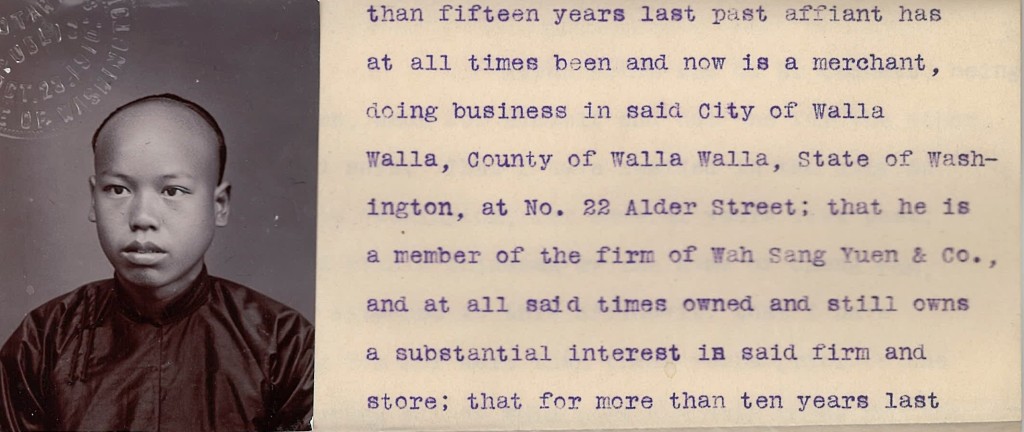

Chong Fong 張芳 was born on 12 July 1889 in Sun Gee village, Sun Ning, Kwong Tung, China. In June 1908 his father, Chong Tom, officially started the process of bringing his son into the United States. Chong Tom, Alvah Brown, C. B. Cashatt, Quong Sin, and Quong Shik, swore in affidavits that Chong Fong was the minor son of Chong Tom, a merchant at the Wah Sang Yuen Company in Walla Walla, Washington.
Fisher interviewed two Caucasian witnesses to verify the statements made by the Chinese. C. B. Cashatt stated that he had lived in Walla Walla for about thirteen years. He was on the police force and knew Chong Fong’s father, Chong Tom for eight or nine years. He thought he would know if Chong Tom had done any manual labor in the last year. Alvah Brown, the former Chief of Police, also testified. He had known Chong Tom for about twenty-four years. To the best of his knowledge, Chong Tom had done no manual labor for the last year. He was a merchant. Both men correctly identified photos of Chong Tom.
Chong Tom testified that he arrived in the United States about 1880, moved to Walla Walla around 1881, but was in China at the time when the Chinese were required to register (Geary Act of 1892) so he did not register. Chong Tom was one of ten partners in the Wah Sang Yuen Company. They had each invested $1,000. He had made four trips to China after his initial arrival. He left and returned from various ports—San Francisco, Seattle, Port Townsend, and Sumas. He sent Chong Fong $150 in Mexican money to cover the expense of his trip to the U.S.
Quong Shuk was also interviewed in 1908. He lived in Portland, Oregon when he first arrived but had been in Walla Walla about sixteen years. He was in business with his brother, Chong Tom. Chong Toy was his son.
Chung Quong Sin testified that he was Chong Tom’s brother. He had been in Walla Walla for twenty-eight years and was a partner and merchant for the Wah Sang Yuen Company. Chong Fong was his nephew. When asked if he talked to Chong Tom’s wife, Wong She, when he visited China, he said it wasn’t the custom for a man and “a lady” to have a common conversation but they occasionally talked business.
Chong Fong arrived in Sumas, Washington on 19 October 1908. He was interviewed by immigration agents. His father and other witnesses were reinterviewed. Chong Fong was asked many questions about his father’s family including his extended family, the number of siblings he had, and where they were living. He correctly identified photos of his uncle, Chong Quong Sheck (Shuk), and cousin, Chong Toy who were living in Walla Walla. The examiner, Thomas W. Fisher, noted that Chong Fong’s testimony agreed with his father’s.
After reviewing the papers and application of Chong Fong, Fisher decided that Chong Fong was entitled to admission and Fong was admitted on 29 October 1908. Chong Fong sometimes spelled is name Chung Fong.

On 2 October 1913, Chong Fong applied for a return certificate with a merchant status for his upcoming trip to China. He had received an interest in his father’s business as a gift in early October 1912. He was a few days short of the required one year of being a merchant but since he was so close, his application was approved. Chong Tom became the manager of a nearby garden on a ranch after giving his interest in the company to his son.
The Wah Sang Yuen Company sold Chinese groceries and clothing and some American tobacco, candles, and soap. They paid $30 rent per month on the building. The inventory was valued at $7,000-$8,000 and sales were about $16,000 in 1912. The city and county taxes were about $50. Chong Fong received $30 per month in wages. The company was originally located on Alder street in the Keylor Building but moved to a Chinese building on 5th and Rose streets.
Chong Fong’s application required two white witnesses to testify on his behalf. Alvah Brown repeated his testimony of 1908. He lived in Walla Walla about thirty years. During that time, he was an agent for the water company, a policeman, and chief of police, before becoming a clerk at a cigar store at 3rd and Main Street. The interviewer asked Brown, “You have never drawn the line at being acquainted among the Chinese?” Brown answered “no,” and named a few Chinese that he knew: Quong Tuck Fung, Kwong Chung Sing, Wah San Yuen, Kwong Wah Sang, Charley Tung (the Interpreter for this file), Lew Tin Yee, and Chong Fong (the applicant) Fong’s other witness was Mr. V. Hunzicker, owner of a jewelry store at 111 West Main Street, between 3rd and 4th street. He came to Walla Walla about 1888.
Chong Tom testified that the partners in his Walla Walla firm, his brother, Chung Quong Shuk and Chung Quong Sin, were from Sun Gee, the village he was from in China. Sun Gee’s population was over 400 and had about 200 houses. The village was located about one half mile from the Hong Har Chung River. Since first coming to the U.S. Chong Tom had visited China four times.
Lew Tin Yee, manager of the Wah Sang Yuen Company was a witness for Chong Fong. He had been the manager for about fifteen years and had been in the U.S. for 35 years. Quong Shuk testified that he had been in the U.S. for 27 years. He was living in Portland, Oregon at the time of the registration. He lived in Walla Walla for the last 16 years.
Chong Fong, age 26, arrived at the Port of Seattle on 28 June 1915 His arrival interrogation gave the following information: marriage name: Jung Lung Fon, wife: Lee She, 26 years old, had bound feet but removed the bindings, from Chuck Suey Hong, Sunning District. They had one son, Yee Sing. Chong Fong still had a $1,000 interest in the Wah Sang Yuen Company.
He was admitted and received certificate of identity No. 2358.

[This undated photo was included in the file. No names, place or date are given. There is a large X at the bottom of the photo, under the man sitting in the chair. This is probably A. T. Bin Town Chu.]
In December 1913 William Jennings Bryan, Secretary of State, wrote to the Diplomatic and Consular Officers of the U.S.A. to China introducing a delegation in charge of investigating the establishment of a model city in Kwangtung Province: G. J. Corey, John G. Brady, Major John D. Jeffery, Daniel Webster Trotter, C. E. Ferguson, Pierre N. Barringer, and A. T. Bin Town Chu. They planned to build a model city which included facilities for commerce, banking, transportation, education, and religious worship.
Thomas Sammons, American Consul-General wrote to the Commissioner of Immigration in Seattle in March 1914 explaining that A. T. Bin Town Chu left for China without filing the proper paperwork with Immigration authorities. He asked that Chu “be afforded every courtesy” upon his return to the United States.
When Bin Town Chu arrived at the Port of Seattle on 11 April 1914, he testified that he also had the name Ah Too but only used the initials for that part of his name, making his full name A. T. Bin Town Chu. His marriage name was Fung Gow; Chu was his family name. He was 57 years old, had several moles on his face, a scar two inches above the inner end of his left eyebrow, and wore a mustache. [A physical description is listed in the case file of applicants entering the U.S. This description was then compared every time the applicant left the country or returned.]
Upon his arrival back in the U.S., Chu testified that he was born in Haw Leu village, Sunwoi District, China. He first came to the United States in 1871 as a young boy under the name of Ah Too through the Port of San Francisco. About 1880 he went back to China and returned seven months later. He was admitted as a merchant but at that time he was not required to have papers. [The Chinese Exclusion Act was passed in 1882.] He was a member of the Quan Hing Lung Company in New York City. He went back to China in late 1882 or early 1883. He made another round trip about three years later and was admitted as a merchant. His next trip to China was in January 1914. He did not register during the period of registration after the Chinese Exclusion Act was passed and had no papers showing his prior admissions into the country. When he left earlier in 1914, he was in a hurry and did not have time for the required investigation. He was traveling with John G. Brady, former Governor of Alaska and G. J. Corey, former American Consul at Amsterdam and Public Lecturer for the Board of Education of New York City. They intended to establish a model city in Kwang Tung Province, China. They wrote to the Department of State and received a letter of introduction to the diplomatic and consular officers for the U.S. in China.
Lee Woo, manager of Mon Hing & Company, 31 ½ Pell Street, New York City and a witness for A. T. Bin Town Chu, testified in 1914 that Chu was a partner in his firm. There were thirty-five partners; ten of them were active in the store. They were Lee Woo, Lee Yick Quay, Chu Fook, Chu Goon, Lee Ock, Fung Sul Ho, Lim Tung, Ong Toon Neng, Lee Dai Lip, and Ng Yee Fook. Chu Fung Gow, also known as Chu Bin Town or Fung Gow [A.T. Bin Town Chu], had recently been to China. Chu had a $1,500 interest in the firm and would occasionally consult with Lee Woo about managing the firm.
Mr. Brady and Mr. Corey were both witnesses for A. T. Bin Town Chu. They testified that everything Chu said in his interrogation was true. They said their visit to China was purely philanthropical.
A.T. Bin Town Chu was admitted at the Port of Seattle on the day of his arrival.
[A big thank you to Kevin Lee for sharing his family stories on the blog.]
Chear Cheo CHIN 陳超 (1871 – 1939) by Kevin Lee
Better known in English as Cheo CHIN or CHIN Cheo, he spent 58 years of his 67½ year lifetime as a resident of the United States. He was born CHAN Don Fun (pronounced Gon Foon in the local Toisan dialect) on 22 August 1871 in the village of Mi Kong (Mai Gong), Hoi Ping (Kaiping) county, Kwangtung (Guangdong) Province, Imperial China.
He was the 2nd out of 6 consecutive generations – soon to be 7th– of my family to have lived, for a lengthy period of time, in Seattle, Washington State.
CHIN Cheo became “a well-known merchant in Seattle” (as described by Henry A. Monroe, Notary Public, lawyer and later U.S. Commissioner of Immigration), having established the Wing Sang store in Washington over a century ago.
Much of his life was pieced together from his sizeable 60 page National Archives file (almost 1 page for every year in the United States), case # 39184/2-12 (previously 682, 15844 and 30206) located at Sand Point Way, Seattle, along with his 2 Seattle-based sons’ case file numbers 28104 and 7031/325.
He was originally accompanied by his rice-farmer father, CHAN Gin Heung AKA CHIN Yen Hing (1845/46 – 1918/19), on a 21-day voyage across the Pacific Ocean to San Francisco, California in 1881 (“KS 7” or during Emperor Kuang-Su’s 7th year of reign), aged 9½ years old.
The hazardous journey across the wide ocean was made possible by Britain defeating Imperial China in 2 Opium Wars, which opened up 5 ports (including Canton and Hong Kong – both nearby to Mi Kong village) for Western trade, and the 1868 Burlingame Treaty (which legitimised Chinese citizens’ ability to emigrate to the USA). China was a poor country for various reasons (foreign intrusion and pilfering of riches, corruption of the Manchu government, floods and droughts) and therefore, men needed a way to support their families.
As discovered by reading the case file of CHIN Cheo, the borders into the USA prior to 1882 were porous. CHIN Cheo and his father, CHAN Gin Heung AKA CHIN Yen Hing, arrived into the port of San Francisco without any identity documents, stating to an Immigration Inspector decades later, that “we carried no papers at that time.”
Chinese immigrants – almost entirely males – came in droves; 300,000 arrived into the United States from the time of discovery of gold in California in 1849 until the enactment of the Chinese Exclusion Act (CEA) in 1882. When the CEA was passed through Congress and signed-off (after an initial veto) by the U.S. President Chester Arthur, it stemmed the flow of Chinese immigrants when it became a trickle for over 60 years, until it was repealed in 1943.
CHIN Cheo was determined to establish his life in Seattle, as a man of respect in the Chinese community. On the other hand, his father decided that he needed to head back to Mi Kong, China, to see his wife, Tom shee (my great great grandmother), after spending 13 years in the United States working as a laundryman.
CHIN Cheo studied English in Seattle, until about 12 years old. He then began working as a laborer (his tanned complexion from photos in his NARA case file suggests some time was spent outdoors), as a cook in Fort Madison, WA, and finally as a merchant/businessman for over 2 decades in the Chinatown International District. He accumulated significant savings, which he trustingly lent to other Chinese citizens to establish businesses in Seattle. Presumably, he was able to recover all the funds that he had lent out, as he lived a comfortable life in Seattle. Some of his funds, unfortunately, were gambled away by playing mahjong onboard steamships to China in 1899, 1903, 1912, 1919 and on ships returning to the USA in 1900, 1904, 1913 and 1921. Each of his 4 trips back to China, as an adult, produced a child or the adoption of a child.
CHIN Cheo was the organiser, founder, and managing partner of the Wing Sang Company (Seattle) also known as Wing Sang & Co., Seattle, in November 1908 (Chinese calendar) or December 1908 (Western calendar).
The 12 partners each put in capital of US$500, however, only 3 – 4 were active at any one time and drew a salary of US$50 per month. The first 7 partners listed below were specifically named by CHIN Cheo during Immigration interviews, with the last 5 assumed to be:
The Wing Sang Company / Wing Sang & Co., Seattle sold general Chinese merchandise including rice, tea, wine, oil, miscellaneous goods, herbs, drugs/medicines. It held inventory valued at US$2,000 in October 1911, and US$3,000 in December 1912 and April 1926.
The Wing Sang Company / Wing Sang & Co., Seattle was variously located at:
CHIN Cheo was also simultaneously a silent partner in Sang Loon Company / Sang Yuen Co. , having purchased a US$500 interest in 1923. It was newly-opened at 660 King Street, Seattle that year. He then became an active partner on 2 June 1930, ordering groceries, doing-up packages, marking-up prices, and arranging delivery to customers.
He resided at the back of the shop of Wing Sang (Seattle) for 2 decades, and then moved to an upper level apartment above the Sang Loon/Yuen Company in 1930.
CHIN Cheo was determined in life to leave a legacy inside both the village of Mi Kong, China (where his house and treasure chest are currently owned by his adopted son’s son) and in Seattle, USA (where his personal effects such as hat, ties, and spectacles are still being kept by a great granddaughter).
CHIN Cheo left behind 3 blood-related children, via Love SEETO or SEE TOW shee, who have all featured on this Seattle blog website (in addition to a 4th child – an adopted son from the markets near Mi Kong):
CHIN Cheo brought children into this world (the 1st born was in 1900 at age 29) and grandchildren (the 1st born was in 1926 when he was 55) – yet he never really knew them.
His 1st wife, Love SEETO was born in 1875 in Ngo Lew How village, in the Chikan (Chek-ham) region, Hoiping county, was foot-bound, and became heart-broken in 1918 upon learning that their no. 1 son, CHIN Wing Quong died in Seattle at the young age of 18 from self-medicating.
His 2nd wife was FONG / FUNG shee, whom he married at age 49 in 1920 (the 10th year of the Republic of China or “Rep. 10”) during his final trip back to Mi Kong village. He had no children with her, during the brief time he spent with her, before he sailed out of Hong Kong on board the S.S. Empress of Japan on 20 September 1921.
In a quirk of history, his granddaughter Siu Lung Yu’s 余小濃 future husband had a grandfather, LEE Sing Lip (1906 – 1993) and great grandfather, CHENG Fai Sin, both living in Seattle & Vancouver during the early 1900’s, and whom CHIN Cheo most likely knew.
He finally died on Monday 6 March 1939 at 11PM due to cancer of the sigmoid, a part of the bowel, after suffering obstructions for 17 days, and was buried in the Old Chinese Section of Mount Pleasant Cemetery, 700 West Raye Street, Seattle. Hundreds turned out for his funeral, where he was addressed as 陳公 (pronounced as “Chun gūng“) meaning Elder CHAN or Mr CHAN, Senior – a mark of respect for one of Seattle’s early and most reputable Chinese merchants.
